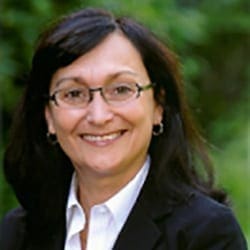A collaborative learning space requires both physical design and pedagogy. Physically, successful collaborative learning spaces need flexibility that quickly and easily facilitate collaboration. According to Robert Sommer, “Space—whether physical or virtual—can have an impact on learning. It can bring people together; it can encourage exploration, collaboration, and discussion. Or, space can carry an unspoken message of silence and disconnectedness.” Students should be able to move from listening to one speaker to working in groups to working independently. Spaces must allow for easy reconfiguration to support different kinds of activity. Pedagogically, learning spaces must “Emphasize the principles of socio-constructivism, spaces must convey co-learning and co-construction of knowledge. Within the classroom, it means avoiding the message that the room has a front or a ‘privileged’ space.”
At Ezra we do not believe in quiet classrooms. We emphasize collaborative, group work. Students are encouraged to problem solve with their peers and to share different approaches to finding solutions. Students and teachers are considered partners in the teaching and learning process. These notions about education necessitate classrooms that are flexible and easily transformable, to facilitate various combinations and groupings of students.
Additionally, we value and engage students in project-based learning. Our students are involved in engineering and science hands-on learning, as well as utilizing makerspace materials, art, and music to enhance their projects. This too requires flexibility in terms of space and configuration of classroom surfaces, to provide spaces that are best suited to these various activities.
As we instituted the multi-aged classroom organizational structure to our school, the first physical change we made was to take down walls between two classrooms, making a physically larger space to house two grade levels of students. It was also meant to facilitate the concept of small group teaching, the use of various learning centers and flexibility in classroom arrangement.
The results of this physical restructuring were somewhat limited. Teachers still tended towards putting student desks in rows and periodically reconfiguring them for group activities. They still tended to speak from one end of the classroom, directing their talk at the students, and students did not have the opportunities to interact with one another unless their teachers chose to push their desks together. Despite a “buy in” from the faculty on all of the conceptual models of progressive, collaborative teaching and learning, it was not happening in an organic way that flowed throughout the day.
It then struck me that the ease of movement and physical change was still inhibited in the classroom. It was simply just easier to set up desks in rows and for teachers to instruct from the one spot. In an instant I intuited that we had to significantly change up the rooms’ structure. I browsed the internet, went to my favorite, inexpensive, school supplier and began looking at classroom furniture. In the end, I settled upon inexpensive, trapezoidal tables that could be configured in any number of ways to make seating flexible in the classroom. I ordered them immediately and when they arrived I took every desk out of the classroom.
Almost immediately things began to change. The students were very excited and relished this new experience of having their classmates in close proximity. The teachers were thrilled with the flexibility these tables offered. Each time I walked into these classrooms there were changes in configurations and students were engaging each other in listening and learning. The teachers were no longer at the front of the room but walking among the tables and groups of students, checking in, lending support where needed, or conducting small group lessons of their own.
Perhaps most interesting of all was the response of those teachers not yet in the multi-age program. Within a week of the tables arriving, I began to get requests to order more tables for use in their classrooms. By the end of that school year, all but two teachers had trapezoid tables in their classrooms and it was quite evident that the nature of teaching in those rooms was beginning to shift. Students’ collaborative engagement became more organic. Teachers became more flexible in the way they structured their lessons and the entire school community began to understand, in a visceral way, what it meant to be a collaborative learning environment.
It is clear that this success was not solely the result of a table, but was an ongoing process of learning, discussion, and reflection on the part of the school community. Yet, it was the tables that perhaps made us more nimble and helped us all to think more flexibly. The teachers gained confidence in the notion of change and saw the success small change could bring about. In the past 7 years our faculty have pushed the notion of change and have embraced not only a multiage classroom structure but outdoor education and collaboration with schools across the country to develop a Social Justice curriculum. They have given up teaching a second language, replacing it with coding and computer science, the language of the 21st century. They continue to write curricula, create learning experiences, and collaborate with their counterparts to genuinely integrate Judaic content, ethics, and Torah into the curriculum. As a faculty, we have renewed and invigorated our spirits, our commitment to educating the whole child, and our dedication to infusing Judaism into all we create. We continue to welcome the opportunity to create and recreate the educational experiences our school offers and we embrace the lessons that we have encountered along the way in this extraordinary journey.





